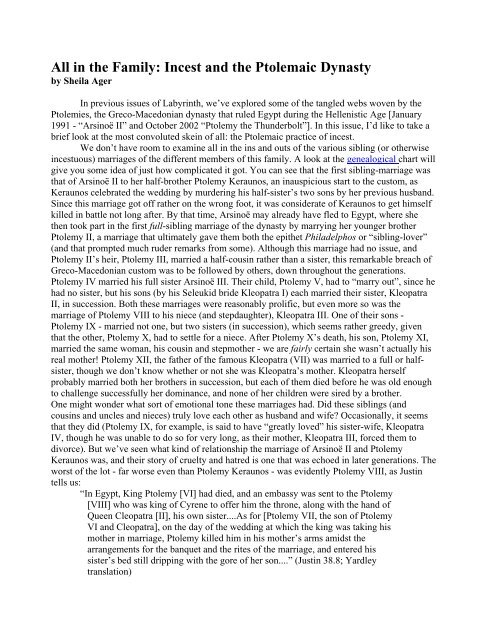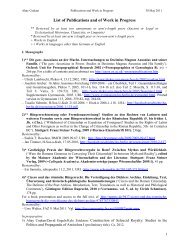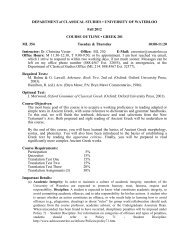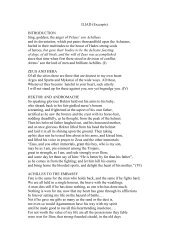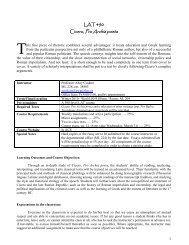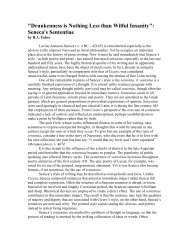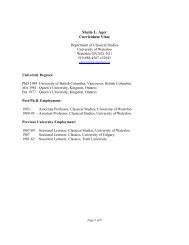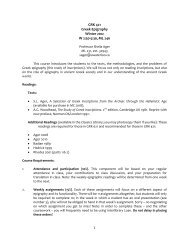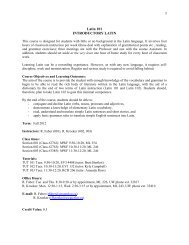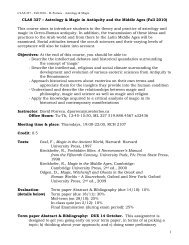All in the Family: Incest and the Ptolemaic Dynasty
All in the Family: Incest and the Ptolemaic Dynasty
All in the Family: Incest and the Ptolemaic Dynasty
Create successful ePaper yourself
Turn your PDF publications into a flip-book with our unique Google optimized e-Paper software.
<strong>All</strong> <strong>in</strong> <strong>the</strong> <strong>Family</strong>: <strong>Incest</strong> <strong>and</strong> <strong>the</strong> <strong>Ptolemaic</strong> <strong>Dynasty</strong><br />
by Sheila Ager<br />
In previous issues of Labyr<strong>in</strong>th, we’ve explored some of <strong>the</strong> tangled webs woven by <strong>the</strong><br />
Ptolemies, <strong>the</strong> Greco-Macedonian dynasty that ruled Egypt dur<strong>in</strong>g <strong>the</strong> Hellenistic Age [January<br />
1991 - “Ars<strong>in</strong>oë II” <strong>and</strong> October 2002 “Ptolemy <strong>the</strong> Thunderbolt”]. In this issue, I’d like to take a<br />
brief look at <strong>the</strong> most convoluted ske<strong>in</strong> of all: <strong>the</strong> <strong>Ptolemaic</strong> practice of <strong>in</strong>cest.<br />
We don’t have room to exam<strong>in</strong>e all <strong>in</strong> <strong>the</strong> <strong>in</strong>s <strong>and</strong> outs of <strong>the</strong> various sibl<strong>in</strong>g (or o<strong>the</strong>rwise<br />
<strong>in</strong>cestuous) marriages of <strong>the</strong> different members of this family. A look at <strong>the</strong> genealogical chart will<br />
give you some idea of just how complicated it got. You can see that <strong>the</strong> first sibl<strong>in</strong>g-marriage was<br />
that of Ars<strong>in</strong>oë II to her half-bro<strong>the</strong>r Ptolemy Keraunos, an <strong>in</strong>auspicious start to <strong>the</strong> custom, as<br />
Keraunos celebrated <strong>the</strong> wedd<strong>in</strong>g by murder<strong>in</strong>g his half-sister’s two sons by her previous husb<strong>and</strong>.<br />
S<strong>in</strong>ce this marriage got off ra<strong>the</strong>r on <strong>the</strong> wrong foot, it was considerate of Keraunos to get himself<br />
killed <strong>in</strong> battle not long after. By that time, Ars<strong>in</strong>oë may already have fled to Egypt, where she<br />
<strong>the</strong>n took part <strong>in</strong> <strong>the</strong> first full-sibl<strong>in</strong>g marriage of <strong>the</strong> dynasty by marry<strong>in</strong>g her younger bro<strong>the</strong>r<br />
Ptolemy II, a marriage that ultimately gave <strong>the</strong>m both <strong>the</strong> epi<strong>the</strong>t Philadelphos or “sibl<strong>in</strong>g-lover”<br />
(<strong>and</strong> that prompted much ruder remarks from some). Although this marriage had no issue, <strong>and</strong><br />
Ptolemy II’s heir, Ptolemy III, married a half-cous<strong>in</strong> ra<strong>the</strong>r than a sister, this remarkable breach of<br />
Greco-Macedonian custom was to be followed by o<strong>the</strong>rs, down throughout <strong>the</strong> generations.<br />
Ptolemy IV married his full sister Ars<strong>in</strong>oë III. Their child, Ptolemy V, had to “marry out”, s<strong>in</strong>ce he<br />
had no sister, but his sons (by his Seleukid bride Kleopatra I) each married <strong>the</strong>ir sister, Kleopatra<br />
II, <strong>in</strong> succession. Both <strong>the</strong>se marriages were reasonably prolific, but even more so was <strong>the</strong><br />
marriage of Ptolemy VIII to his niece (<strong>and</strong> stepdaughter), Kleopatra III. One of <strong>the</strong>ir sons -<br />
Ptolemy IX - married not one, but two sisters (<strong>in</strong> succession), which seems ra<strong>the</strong>r greedy, given<br />
that <strong>the</strong> o<strong>the</strong>r, Ptolemy X, had to settle for a niece. After Ptolemy X’s death, his son, Ptolemy XI,<br />
married <strong>the</strong> same woman, his cous<strong>in</strong> <strong>and</strong> stepmo<strong>the</strong>r - we are fairly certa<strong>in</strong> she wasn’t actually his<br />
real mo<strong>the</strong>r! Ptolemy XII, <strong>the</strong> fa<strong>the</strong>r of <strong>the</strong> famous Kleopatra (VII) was married to a full or halfsister,<br />
though we don’t know whe<strong>the</strong>r or not she was Kleopatra’s mo<strong>the</strong>r. Kleopatra herself<br />
probably married both her bro<strong>the</strong>rs <strong>in</strong> succession, but each of <strong>the</strong>m died before he was old enough<br />
to challenge successfully her dom<strong>in</strong>ance, <strong>and</strong> none of her children were sired by a bro<strong>the</strong>r.<br />
One might wonder what sort of emotional tone <strong>the</strong>se marriages had. Did <strong>the</strong>se sibl<strong>in</strong>gs (<strong>and</strong><br />
cous<strong>in</strong>s <strong>and</strong> uncles <strong>and</strong> nieces) truly love each o<strong>the</strong>r as husb<strong>and</strong> <strong>and</strong> wife? Occasionally, it seems<br />
that <strong>the</strong>y did (Ptolemy IX, for example, is said to have “greatly loved” his sister-wife, Kleopatra<br />
IV, though he was unable to do so for very long, as <strong>the</strong>ir mo<strong>the</strong>r, Kleopatra III, forced <strong>the</strong>m to<br />
divorce). But we’ve seen what k<strong>in</strong>d of relationship <strong>the</strong> marriage of Ars<strong>in</strong>oë II <strong>and</strong> Ptolemy<br />
Keraunos was, <strong>and</strong> <strong>the</strong>ir story of cruelty <strong>and</strong> hatred is one that was echoed <strong>in</strong> later generations. The<br />
worst of <strong>the</strong> lot - far worse even than Ptolemy Keraunos - was evidently Ptolemy VIII, as Just<strong>in</strong><br />
tells us:<br />
“In Egypt, K<strong>in</strong>g Ptolemy [VI] had died, <strong>and</strong> an embassy was sent to <strong>the</strong> Ptolemy<br />
[VIII] who was k<strong>in</strong>g of Cyrene to offer him <strong>the</strong> throne, along with <strong>the</strong> h<strong>and</strong> of<br />
Queen Cleopatra [II], his own sister....As for [Ptolemy VII, <strong>the</strong> son of Ptolemy<br />
VI <strong>and</strong> Cleopatra], on <strong>the</strong> day of <strong>the</strong> wedd<strong>in</strong>g at which <strong>the</strong> k<strong>in</strong>g was tak<strong>in</strong>g his<br />
mo<strong>the</strong>r <strong>in</strong> marriage, Ptolemy killed him <strong>in</strong> his mo<strong>the</strong>r’s arms amidst <strong>the</strong><br />
arrangements for <strong>the</strong> banquet <strong>and</strong> <strong>the</strong> rites of <strong>the</strong> marriage, <strong>and</strong> entered his<br />
sister’s bed still dripp<strong>in</strong>g with <strong>the</strong> gore of her son....” (Just<strong>in</strong> 38.8; Yardley<br />
translation)
Ano<strong>the</strong>r <strong>in</strong>auspicious beg<strong>in</strong>n<strong>in</strong>g (<strong>and</strong> suspiciously similar to Just<strong>in</strong>’s account of <strong>the</strong><br />
marriage of Ars<strong>in</strong>oë II <strong>and</strong> Keraunos). If Kleopatra II didn’t already hate her younger bro<strong>the</strong>r -<br />
now her husb<strong>and</strong> - <strong>the</strong> murder of her young son would surely have provoked such a sentiment. She<br />
cannot have been much more endeared to her new mate by his next actions. Ei<strong>the</strong>r by rape or<br />
seduction, Ptolemy VIII fa<strong>the</strong>red a son on her daughter, Kleopatra III, <strong>and</strong> subsequently married<br />
her. Whe<strong>the</strong>r he divorced Kleopatra II or not is unclear. The three ruled toge<strong>the</strong>r <strong>in</strong> what’s been<br />
called “an unholy ménage à trois” until 116, when Ptolemy died. It was a far from peaceful reign.<br />
At one po<strong>in</strong>t, for example, Kleopatra II succeeded <strong>in</strong> temporarily oust<strong>in</strong>g her bro<strong>the</strong>r <strong>and</strong> her<br />
daughter from Alex<strong>and</strong>ria, <strong>and</strong> reigned <strong>the</strong>re alone for a time. On this occasion, Ptolemy once<br />
aga<strong>in</strong> displayed his peculiar hatefulness by murder<strong>in</strong>g Kleopatra’s last rema<strong>in</strong><strong>in</strong>g son, Ptolemy<br />
Memphites - who was also his own child - dismember<strong>in</strong>g <strong>the</strong> body, putt<strong>in</strong>g it <strong>in</strong> a box <strong>and</strong><br />
despatch<strong>in</strong>g it to <strong>the</strong> boy’s mo<strong>the</strong>r as a birthday present.<br />
Small wonder that Peter Green has characterized <strong>the</strong> <strong>Ptolemaic</strong> dynasty as morally<br />
depraved:<br />
“If <strong>the</strong> word ‘degeneration’ has any mean<strong>in</strong>g at all, <strong>the</strong>n <strong>the</strong><br />
later...Ptolemies were degenerate: selfish, greedy, murderous, weak,<br />
stupid, vicious, sensual, vengeful, <strong>and</strong>...suffer<strong>in</strong>g from <strong>the</strong> effects of<br />
prolonged <strong>and</strong> repeated <strong>in</strong>breed<strong>in</strong>g.” (Alex<strong>and</strong>er to Actium, Berkeley/Los<br />
Angeles 1990, p. 554). Michael Grant takes it one step fur<strong>the</strong>r <strong>in</strong> his<br />
biography of Kleopatra VII: “certa<strong>in</strong> elements <strong>in</strong> her character may have<br />
been due to this persistent <strong>in</strong>breed<strong>in</strong>g - notably her total absence of moral<br />
sense, <strong>and</strong> a tendency to murder her bro<strong>the</strong>rs <strong>and</strong> sisters which may have<br />
been partly an <strong>in</strong>herited family habit.” (Cleopatra, New York 1972, p. 27)<br />
But Ptolemy VIII’s <strong>and</strong> Kleopatra VII’s behaviour cannot be ascribed to <strong>in</strong>breed<strong>in</strong>g. I th<strong>in</strong>k<br />
we’re probably safe <strong>in</strong> say<strong>in</strong>g that <strong>Ptolemaic</strong> moral behaviour is likely to have been <strong>the</strong> result of<br />
nurture (or perhaps <strong>the</strong> lack <strong>the</strong>reof) ra<strong>the</strong>r than nature. I don’t believe we need spend much time<br />
on <strong>the</strong> question of whe<strong>the</strong>r Kleopatra, as a k<strong>in</strong>d of <strong>Ptolemaic</strong> “bad seed”, actually <strong>in</strong>herited a<br />
concentrated set of chromosomes genetically programm<strong>in</strong>g her to murder her sibl<strong>in</strong>gs.<br />
Never<strong>the</strong>less, what about <strong>the</strong> actual physical effects of <strong>in</strong>breed<strong>in</strong>g on <strong>the</strong> Ptolemies?<br />
Ptolemy VIII, popularly (or perhaps unpopularly) known as Physkon (“Pot-Belly”) among<br />
<strong>the</strong> Alex<strong>and</strong>rians, is sometimes brought forward as an example of <strong>the</strong> deleterious physical effects<br />
of <strong>in</strong>cest among <strong>the</strong> Ptolemies (despite <strong>the</strong> fact that Ptolemy VIII was not himself <strong>in</strong>bred). Co<strong>in</strong><br />
portraits <strong>and</strong> sculptures of this member of <strong>the</strong> clan show him to have been quite heavy, <strong>and</strong> <strong>the</strong><br />
picture is “fleshed out” (as it were) by literary descriptions of him:<br />
“To <strong>the</strong> Romans...he was as ludicrous a figure as he was a cruel one to<br />
his fellow-citizens. He had an ugly face, <strong>and</strong> was short <strong>in</strong> stature; <strong>and</strong> he<br />
had a distended belly more like an animal’s than a man’s. The<br />
repulsiveness of his appearance was heightened by his dress, which was<br />
exceed<strong>in</strong>gly f<strong>in</strong>e-spun to <strong>the</strong> po<strong>in</strong>t of transparency, just as if he had some<br />
motive for putt<strong>in</strong>g on display what a decent man should have made<br />
every effort to conceal.” (Just<strong>in</strong> 38.8; Yardley translation.)<br />
A repellent outer man to match <strong>the</strong> repellent <strong>in</strong>ner man. But even leav<strong>in</strong>g aside <strong>the</strong> issue of<br />
source bias (bound to exaggerate negative characteristics), it’s very clear from o<strong>the</strong>r sources that<br />
Ptolemy VIII’s weight problem was a matter of lifestyle - he is said to have lived a life of<br />
tremendous luxury <strong>and</strong> self-<strong>in</strong>dulgence. There is no need to posit a freak recessive “fat” gene <strong>in</strong> <strong>the</strong><br />
<strong>Ptolemaic</strong> clan, made dom<strong>in</strong>ant by repeated <strong>in</strong>cest.
So while it is certa<strong>in</strong>ly true that <strong>in</strong>breed<strong>in</strong>g - especially when carried on at such a close degree of<br />
relationship as it was among <strong>the</strong> Ptolemies - can have harmful genetic effects, <strong>the</strong> fact rema<strong>in</strong>s that<br />
we really do not have sufficient evidence to demonstrate <strong>in</strong>controvertibly that <strong>the</strong> Ptolemies were<br />
physically affected by <strong>the</strong>ir <strong>in</strong>cestuous behaviour. They may <strong>the</strong>refore have found <strong>in</strong>cest <strong>and</strong><br />
<strong>in</strong>breed<strong>in</strong>g a supportable method of dynastic propagation. But supportability is not <strong>the</strong> same as<br />
desirability. Why should <strong>the</strong>y have adopted this pattern <strong>in</strong> <strong>the</strong> first place, <strong>and</strong> adhered to it so<br />
stubbornly?<br />
The phenomenon of <strong>in</strong>cestuous marriage <strong>in</strong> <strong>the</strong> <strong>Ptolemaic</strong> house is no doubt someth<strong>in</strong>g that<br />
had complex causation, <strong>and</strong> some of <strong>the</strong> rationales might well have become apparent to <strong>the</strong><br />
Ptolemies <strong>the</strong>mselves only after <strong>the</strong> fact, if at all. There may have been a desire to <strong>in</strong>gratiate<br />
<strong>the</strong>mselves with <strong>the</strong> Egyptian population by copy<strong>in</strong>g <strong>the</strong> customs of <strong>the</strong> Egyptian Pharaohs, though<br />
this argument has certa<strong>in</strong> weaknesses we don’t have room to explore here. Ano<strong>the</strong>r reason may be<br />
that <strong>the</strong>re were times <strong>and</strong> political circumstances dur<strong>in</strong>g which <strong>the</strong> Ptolemies preferred to “marry<br />
<strong>in</strong>” ra<strong>the</strong>r than risk entangl<strong>in</strong>g <strong>the</strong>mselves with one of <strong>the</strong> o<strong>the</strong>r Greco-Macedonian dynasties such<br />
as <strong>the</strong> Seleukids or Antigonids, with whom <strong>the</strong>y were often at war. Marry<strong>in</strong>g <strong>the</strong>ir sisters<br />
<strong>the</strong>mselves (ra<strong>the</strong>r than marry<strong>in</strong>g <strong>the</strong>m off <strong>in</strong>to ano<strong>the</strong>r dynasty) also controlled <strong>the</strong> offspr<strong>in</strong>g of<br />
those sisters - <strong>Ptolemaic</strong> women, <strong>and</strong> <strong>the</strong>ir sons by non-<strong>Ptolemaic</strong> men, could be a very feisty<br />
bunch. <strong>Incest</strong>uous marriage also had <strong>the</strong> advantage of ma<strong>in</strong>ta<strong>in</strong><strong>in</strong>g <strong>the</strong> “purity” of <strong>the</strong> blood-l<strong>in</strong>e<br />
(though whe<strong>the</strong>r <strong>the</strong> Ptolemies truly thought of <strong>the</strong>mselves as <strong>in</strong> any way “pure” is ano<strong>the</strong>r matter).<br />
Fur<strong>the</strong>rmore, it assimilated those who practiced it to <strong>the</strong> div<strong>in</strong>e world, s<strong>in</strong>ce <strong>the</strong> gods - <strong>the</strong> Greek<br />
gods Zeus <strong>and</strong> Hera, as well as <strong>the</strong> Egyptian gods Isis <strong>and</strong> Osiris - practiced sibl<strong>in</strong>g marriage.<br />
One motivation that may always have rema<strong>in</strong>ed below <strong>the</strong> threshold of conscious recognition is <strong>the</strong><br />
one most likely to have been shared with o<strong>the</strong>r human cultures which have also practiced royal<br />
sibl<strong>in</strong>g <strong>in</strong>cest. It’s often stated, erroneously, that <strong>the</strong> “<strong>in</strong>cest taboo” is universal, <strong>and</strong> that cases of<br />
royal <strong>in</strong>cest represent a “break<strong>in</strong>g” of that taboo. But such an <strong>in</strong>terpretation is not quite accurate to<br />
<strong>the</strong> orig<strong>in</strong>al mean<strong>in</strong>g of <strong>the</strong> word. “Taboo” means “set apart for or consecrated to a special use or<br />
purpose; restricted to <strong>the</strong> use of a god, a k<strong>in</strong>g, priests, or chiefs, while forbidden to general use;<br />
<strong>in</strong>violable, sacred” (Oxford English Dictionary). <strong>Ptolemaic</strong> k<strong>in</strong>gs did not “break” a taboo by<br />
marry<strong>in</strong>g <strong>the</strong>ir sisters. It would be better to say that <strong>the</strong>y fulfilled a taboo <strong>and</strong> gave it mean<strong>in</strong>g by<br />
cross<strong>in</strong>g a boundary that is barred to ord<strong>in</strong>ary people. In so do<strong>in</strong>g <strong>the</strong>y demonstrated that <strong>the</strong>y were<br />
extra-ord<strong>in</strong>ary. We’ve come full circle to <strong>the</strong> issue of div<strong>in</strong>ity aga<strong>in</strong>, but it’s about more than a<br />
simple assimilation of royalty to <strong>the</strong> gods. It’s about human power as well, <strong>and</strong> about subconscious<br />
<strong>and</strong> perhaps universal human <strong>in</strong>st<strong>in</strong>cts that <strong>the</strong>re is someth<strong>in</strong>g “num<strong>in</strong>ous” about those who<br />
transgress such boundaries. It is precisely this transgression that gives Oedipus <strong>the</strong> num<strong>in</strong>ous<br />
power he displays at <strong>the</strong> end of his life. If a taboo is a th<strong>in</strong>g that is “set apart”, <strong>the</strong>n <strong>the</strong> Ptolemies<br />
by <strong>the</strong>ir actions became “taboo” - truly set apart, unreachable by ord<strong>in</strong>ary humans, <strong>and</strong> not to be<br />
judged by ord<strong>in</strong>ary st<strong>and</strong>ards of human behaviour.


